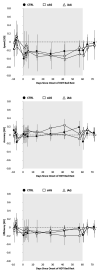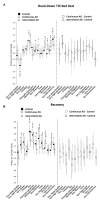Continuous and Intermittent Artificial Gravity as a Countermeasure to the Cognitive Effects of 60 Days of Head-Down Tilt Bed Rest
- PMID: 33815148
- PMCID: PMC8009974
- DOI: 10.3389/fphys.2021.643854
Continuous and Intermittent Artificial Gravity as a Countermeasure to the Cognitive Effects of 60 Days of Head-Down Tilt Bed Rest
Abstract
Environmental and psychological stressors can adversely affect astronaut cognitive performance in space. This study used a 6° head-down tilt bed rest (HDBR) paradigm to simulate some of the physiologic changes induced by microgravity. Twenty-four participants (mean ± SD age 33.3 ± 9.2 years, N = 16 men) spent 60 consecutive days in strict HDBR. They were studied in three groups of eight subjects each. One group served as Control, whereas the other two groups received either a continuous or intermittent artificial gravity (AG) countermeasure of 30 min centrifugation daily (1 g acceleration at the center of mass and 2 g at the feet). Participants performed all 10 tests of NASA's Cognition battery and a brief alertness and mood survey repeatedly before, during, and after the HDBR period. Test scores were adjusted for practice and stimulus set difficulty effects. A modest but statistically significant slowing across a range of cognitive domains was found in all three groups during HDBR compared to baseline, most consistently for sensorimotor speed, whereas accuracy was unaffected. These changes were observed early during HDBR and did not further worsen or improve with increasing time in HDBR, except for emotion recognition performance. With increasing time spent in HDBR, participants required longer time to decide which facial emotion was expressed. They were also more likely to select categories with negative valence over categories with neutral or positive valence. Except for workload, which was rated lower in the Control group, continuous or intermittent AG did not modify the effect of HDBR on cognitive performance or subjective responses. Participants expressed several negative survey responses during HDBR relative to baseline, and some of the responses further deteriorated during recovery, which highlights the importance of adequate medical and psychological support during extended duration HDBR studies. In conclusion, 60 days of HDBR were associated with moderate cognitive slowing and changes in emotion recognition performance, but these effects were not mitigated by either continuous or intermittent exposure to AG for 30 min daily.
Keywords: bed rest; cognition; emotion recognition; microgravity; performance; spaceflight.
Copyright © 2021 Basner, Dinges, Howard, Moore, Gur, Mühl and Stahn.
Conflict of interest statement
The authors declare that the research was conducted in the absence of any commercial or financial relationships that could be construed as a potential conflict of interest.
Figures





References
-
- Barger L. K., Flynn-Evans E. E., Kubey A., Walsh L., Ronda J. M., Wang W., et al. . (2014). Prevalence of sleep deficiency and hypnotic use among astronauts before, during and after spaceflight: an observational study. Lancet Neurol. 13, 904–912. 10.1016/S1474-4422(14)70122-X, PMID: - DOI - PMC - PubMed
-
- Basner M., Hermosillo E., Nasrini J., Saxena S., Dinges D. F., Moore T. M., et al. . (2020a). Cognition test battery: adjusting for practice and stimulus set effects for varying administration intervals in high performing individuals. J. Clin. Exp. Neuropsychol. 42, 516–529. 10.1080/13803395.2020.1773765, PMID: - DOI - PMC - PubMed
Grants and funding
LinkOut - more resources
Full Text Sources
Other Literature Sources

